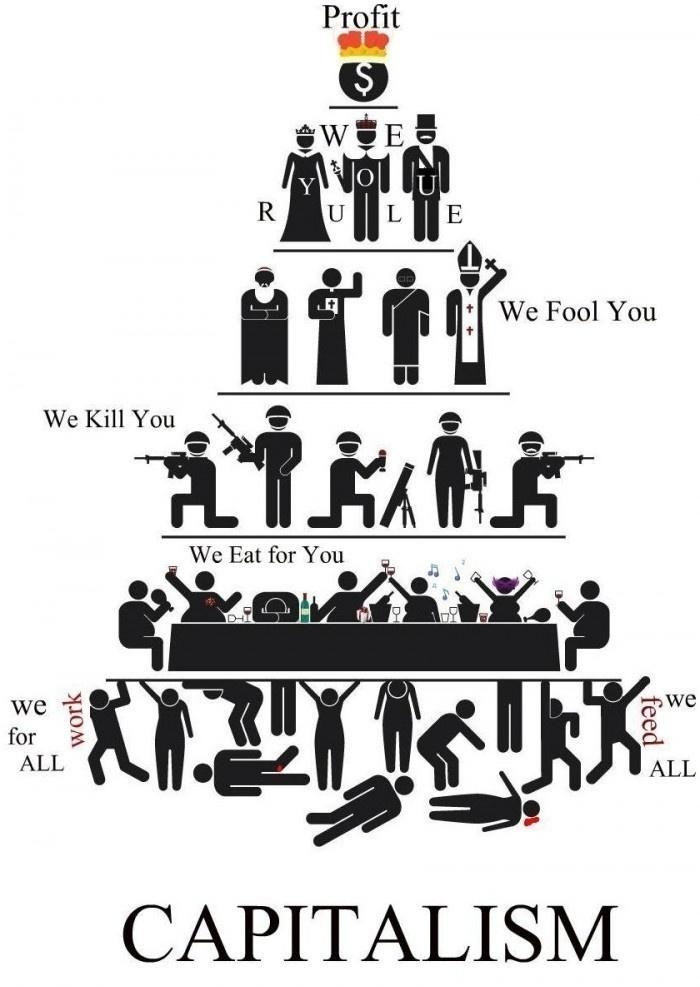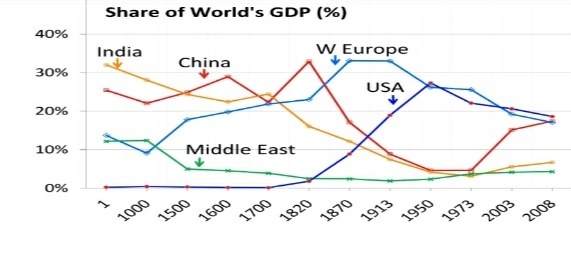CAPITALISM
Capitalism can be traced back to early forms of merchant capitalism practiced in Western Europe during the Middle-Ages. It began to develop into its modern form during the Early Modern period in the Protestant countries of North-Western Europe, especially the Netherlands and England.
Some of the Preachers of free market were – Adam Smith, John Stuart Mill, David Ricardo, Thomas Malthus, Friedrich Hayek, John Maynard Keynes, Alfred Marshall, Joseph Schumpeter, Max Weber and Ronald Coase.
The current leading countries in capitalism are Germany, United States of America, China, India and Japan.
“Capitalism is an economic system based on private ownership of the means of production and their operation for profit.”
Characteristics central to capitalism include private property, capital accumulation, wage labor, voluntary exchange, a price system, and competitive markets. In a capitalist market economy, decision-making and investment is determined by the owners of the factors of production in financial and capital markets, and prices and the distribution of goods are mainly determined by competition in the market.
Economists, political economists, and historians have adopted different perspectives in their analyses of capitalism and have recognized various forms of it in practice. These include laissez-faire or free market capitalism, welfare capitalism, and state capitalism.
Capitalism is the social system which now exists in all countries of the world. Under this system, the means for producing and distributing goods (the land, factories, technology, transport system etc) are owned by a small minority of people referred to as the “Capitalist class”. The majority of people must sell their ability to work in return for a wage or salary.
SOCIALISM
The Communist Manifesto was written by Karl Marx and Friedrich Engels, in 1848 just before the Revolutions of 1848 swept Europe, expressing what they termed as ‘scientific socialism’. In the last third of the 19th century in Europe social democratic parties arose in Europe drawing mainly from Marxism.
The modern definition and usage of “socialism” settled by the 1860s, becoming the predominant term among the group of words “co-operative”, “mutualist” and “associationist”.
Some of the socialist countries are China, Denmark, Finland, Netherlands, Canada, Sweden, Norway and Ireland.
“Socialism is a range of economic and social systems characterised by social ownership and democratic control of the means of production; as well as the political ideologies, theories, and movements that aim at their establishment. Social ownership may refer to forms of public, collective, or cooperative ownership; to citizen ownership of equity; or to any combination of these.”
SOCIALISM V/S CAPITALISM
The major differences between capitalism and socialism revolve around the role of the government and equality of economics. Capitalism affords economic freedom, consumer choice, and economic growth. Socialism, which is an economy controlled by the state and planned by a central planning authority, provides for a greater social welfare and decreases business fluctuations.
In capitalism the government should not interfere in the economies of the free market and the government interference is only allowed when making and enforcing rules or policies governing the conduct of business whereas in socialism it is believed that economic inequality is bad for the society, and hence the government is responsible for reducing it via programs that benefit the poor.
In reality there are no pure capitalist or socialist countries in the world, rather you could consider each principle to be at either end of a spectrum and some countries are closer to being Capitalist or closer to being Socialist. Most countries have some free market principles but also have some broad social benefit principles in place. People tend to view the United States as being closer to the Capitalist principles, and countries like Canada or Norway being more Socialist in nature. In reality they are all a mix of the two principles, just a little more leaning in one direction or the other.
POPULISM
Populism is a political style of action that mobilizes a large alienated element of population against a government seen as controlled by an out-of-touch closed elite that acts on behalf of its own interests. Its goal is to unite the non-corrupt and the unsophisticated against the corrupt dominant elites and their camp followers.
Populism is most common in democratic nations.
Political scientist Cas Mudde wrote that, “Many observers have noted that populism is inherent to representative democracy; after all, do populists not juxtapose ‘the pure people’ against ‘the corrupt elite’?”
Populism has been an important force in Latin American political history, where many charismatic leaders have emerged since the beginning of the 20th century, as the paramountcy of agrarian oligarchies had been dislocated by the onset of industrial capitalism, allowing the emergence of an industrial bourgeoisie and the activation of an urban working class which then caused the emergence of reformist and multi-class nationalist politics.
The philosophy of anti-globalisation is based on the belief that individuals and organizations can achieve social, personal and economic goals without the negative consequences associated with capitalism. The anti-globalization movement places more emphasis on economic efficiency and human decency versus corporate competition and profits at any cost.
“The anti-globalization movement, or counter-globalisation movement,is a social movement critical of the globalization of corporate capitalism. The movement is also commonly referred to as the global justice movement, alter-globalization movement, anti-globalist movement, anti-corporate globalization movement, or movement against neo-liberal globalization”
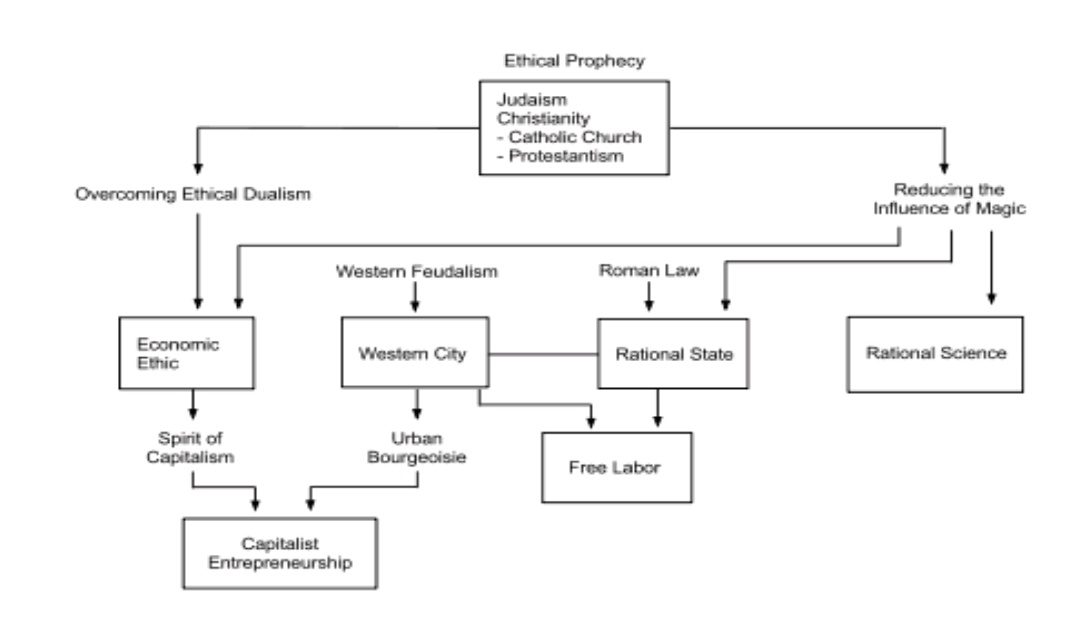
IS GLOBALISATION NEARING its DEATH?
Britain and America were the two leading economies which propagated free markets and capitalism. In the 19th Century, America grew its economic and military muscle power. China and India started their economic reforms in the seventies and nineties respectively. China became one of the fastest growing markets, for over 30 years, it became de facto manufacturing factory to the world.
The chart explains us how initially India and China enjoyed 50% World GDP. During the 18th – 19th Century, they observed a low in their world GDP %. In the year 2008, India and Middle East had the lowest of approximately 10% World GDP whereas China, Western Europe and USA enjoyed a much higher World GDP.
The problems of slow income growth afflicting low and middle class workers in rich countries are widely attributed to globalization. Within economic policy circles, a figure known as the “Elephant Chart,” produced by the former World Bank economist “Branko Milanovic”, seems to offer dramatic proof of that proposition. The chart shows graphically how the incomes of the world’s poor and the world’s richest people have grown sharply over time, but it also identifies a group caught in the middle where incomes stagnated. This group was mistakenly identified as the low and middle classes of mature economies like the United States.
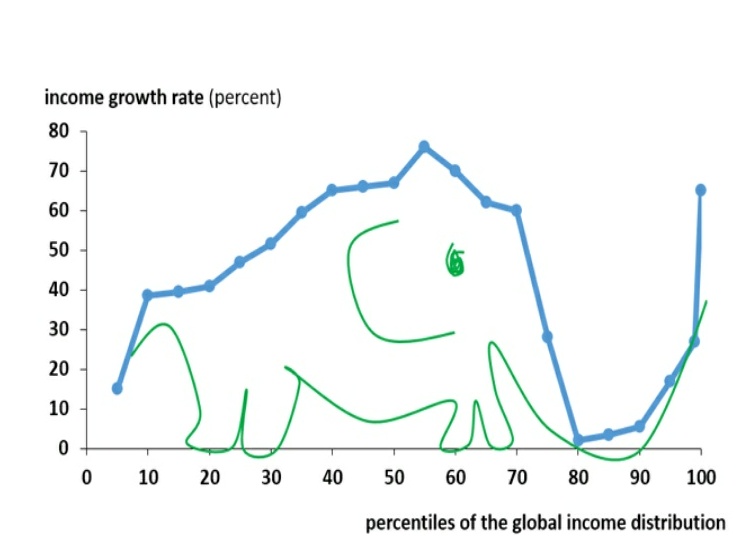 The above diagram takes the world’s population, lines it up in percentiles from poorest to richest, and examines the income growth each percentile achieved from 1988 to 2008. The elephant’s hump-shaped back shows the rise of China where millions have seen huge improvements in living standards. The strong income growth for a large share of the world’s population in poor countries is the personal side of “convergence,” the term used to describe the process in which low income countries catch up to rich countries. Over 500 million people were brought out of poverty (living on less than $1.25 per day) because of this change.
The above diagram takes the world’s population, lines it up in percentiles from poorest to richest, and examines the income growth each percentile achieved from 1988 to 2008. The elephant’s hump-shaped back shows the rise of China where millions have seen huge improvements in living standards. The strong income growth for a large share of the world’s population in poor countries is the personal side of “convergence,” the term used to describe the process in which low income countries catch up to rich countries. Over 500 million people were brought out of poverty (living on less than $1.25 per day) because of this change.
The tip of the elephant’s trunk, at the far right, shows that the world’s super-rich countries are much richer than before. The tail at the far left shows that the world’s poorest, mostly from Africa, are only slightly better off than in the past.
The dip around base of the trunk is perceived as showing that incomes of the lower and middle classes in industrial countries have stagnated.
Taken together, many have interpreted the figure as showing that globalization helps poor countries to grow at the expense of the lower and middle classes of rich countries, as Krugman did in his lecture.
A lot of things happened between 1988 and 2008: For example, the fall of the Soviet Union and the economic stagnation of Japan, driven by its rapidly aging population, caused income in those countries to decline or stagnate, irrespective of globalization. While integration was partly responsible for China’s rise, the shift from a state-run economy to private sector growth mattered enormously. An increase in automated production changed the landscape for manufacturing around the world, with fewer workers needed. Worldwide demand also shifted towards new goods, such as computers and software and improved products like flat screen TVs—companies that failed to see these trends were shuttered, replaced by firms producing the new goods. There were also dramatic policy shifts in some advanced countries, particularly the tax cuts and deregulation carried out by President Ronald Reagan in the United States and British Prime Minister Margaret Thatcher.
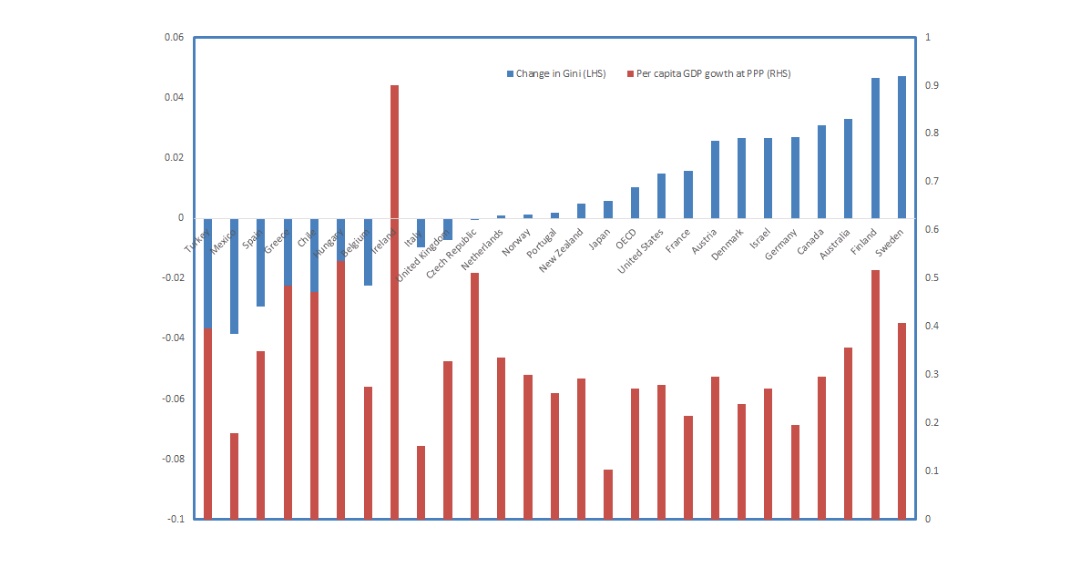 The above figure shows changes in per capita GDP and the Gini-coefficient across OECD countries, from the mid-1990s to the mid-2000s, the period when trade surged. There is significant variation. Real income gains varied between 10 percent in Japan and 90 percent in Ireland. While inequality rose in the United States and nine other countries, inequality declined in Spain and seven other countries, and in eight countries, there was little change in inequality. Overall; there is wide variability in both income growth and inequality despite similar experiences with globalization and technology, suggesting other factors are largely responsible for the changes.
The above figure shows changes in per capita GDP and the Gini-coefficient across OECD countries, from the mid-1990s to the mid-2000s, the period when trade surged. There is significant variation. Real income gains varied between 10 percent in Japan and 90 percent in Ireland. While inequality rose in the United States and nine other countries, inequality declined in Spain and seven other countries, and in eight countries, there was little change in inequality. Overall; there is wide variability in both income growth and inequality despite similar experiences with globalization and technology, suggesting other factors are largely responsible for the changes.
Most incomes grew by 30 to 50 percent and gains were broadly shared across various countries and income groups, with the notable exceptions of the Soviet satellites and Japan. China’s population, much of which was poor, has reaped enormous returns over the period. The most worrisome feature of the graph is that the world’s poorest continue to suffer.
“GLOBAL TRADE” OR “DEATH OF CAPITALISM”?
The Industrial Revolution was the transition to new manufacturing processes in the period from about 1760 to sometime between 1820 and 1840. This transition included going from hand production methods to machines, new chemical manufacturing and iron production processes, improved efficiency of water power, the increasing use of steam power, the development of machine tools and the rise of the factory system.
Textiles were the dominant industry of the Industrial Revolution in terms of employment, value of output and capital invested; the textile industry was also the first to use modern production methods.
In 1789, Samuel Slater took his skills in designing and constructing factories to New England, and he was soon engaged in reproducing the textile mills that helped America with its own industrial revolution.
All the leading countries like China , USA, Japan, Turkey, India, Pakistan , etc lead into Global Trade with one another where they either imported or exported the commodities they held a comparative advantage in and imported the commodities where it held a comparative disadvantage.
There were various organisations and associations that helped in making trade easier like SAFTA, APTA, NAFTA, etc which set various rules for the operation of free and smooth trade.
In the initial years of trade, trading was much easier until everybody realised that there were various tariffs, barriers, quotas, etc imposed on the importing and exporting nations.
Traders also heard about the various duties like the Anti-Dumping duties. For example, the Anti-Dumping duty put by India on China for import of various products which is one of the examples of such obstacles. Heavy export charges or import duties induce two nations not to trade with one another.
The TPP or Trans-Pacific Partnership was also introduced which came into force in the year 2015 which is now no more in practice.
The constant decline and disruption in trade has caused hindrances in the economy and therefore, has led to a rise for one country and a fall to the other but an overall decline.
PRODUCTIVITY
The standard of living and one’s productivity has also been reducing due to lack of jobs and no social security.
The IT graduates and Masters holders are stealing away one another’s job which has resulted in loss of productivity due to death of capitalism …
If a worker has a wage much lower than its caliber then one loses its productivity in the course of its work, it faces inequality at work place and also unfair means which results in lower productivity. A middle class man is unable to achieve a basic standard of living for his family and himself resulting in lower productivity each day.
However, somewhere due to capitalism dying in the economy, the productivity of each human being is being reduced each day and is being dependent on other resources.
IS IT REALLY THE DEATH OF CAPITALISM…….?
By Aditi Goyal
Image source:The 4th edition
One of the articles from The Economic Transcript (February, 2017, issue).
To get your copy subscribe now.

